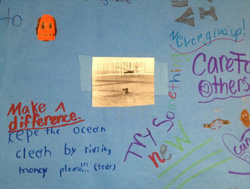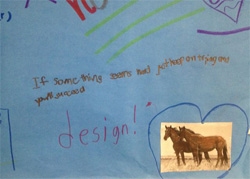by Janice Friesen
This year I worked on a project with a second grade teacher (Stephanie) which totally changed the way she approached teaching and learning in the classroom. She was influenced by Ewan MacIntosh, a Scottish educator who does keynotes on innovation, design thinking, and creativity.
Learn more about Design Thinking on Ewan's Company website or on his blog.
Design Thinking and Learning
Design thinking emphasizes the importance of design in how we do everything. When you look at most classrooms from this perspective you see very teacher-centered rooms. The teacher's desk is the most prominent item in the classroom. The teacher designs all that happens in the room and asks the most questions. In fact students are most used to asking questions with “yes” or “no” answers.

 Sections of the banner the students created
Sections of the banner the students created In order to make this drastic change in her classroom Stephanie had students helped her empty her classroom of everything, including the teacher's desk. They also cleared the walls of the classroom so that they were starting with an empty slate. She explained to the students that the classroom is where they come to work every day. They spent some time brainstorming and talking about what was important for them so that they could learn, and then they all worked together to make a large banner that showed what mattered to them.
The students decided that they needed to have the white boards lower so that they could work on problems using it. They also decided to try a classroom without a teacher's desk.
Two large dry erase boards will be purchased and posted on the walls this summer before next school year, and the teacher did experiment with no teacher's desk.
Chromebooks
Stephanie also received a Google Grant and decided to spend the money on Chromebooks, which are small laptops that work entirely on the browser Chrome. She decided on Chromebooks because they cost around $250. (She could maximize the grant that way.)
Chromebooks do not have another operating system; they use only the browser Chrome. Currently there are many websites available that are interactive, so a browser is effective in the classroom. The Chromebook is not a good choice for people who use software like Photoshop, because there is no way to do some of those things on a browser yet.
The students are all part of the school's Google Network, and they have safe email addresses and accounts with Google so that they can use all of the tools. Google allows them to search the web the same as you would do with any browser. They can do their work in Google Drive, and it is saved right in their own separate area in Google Drive. The students then share their work with their teacher. She can easily access all of the students work in one area of her Google Drive. She can write them notes and save the document, and then the students can see what she has written the next time they open it up.
Google Drive is especially good for working collaboratively on a project. A group of students can set up a document that is shared between them. Then each student can work on it on their own and all of them will see the work. Sometimes it is good to designate a color for each person so that everyone knows who has changed the text. Even better is the fact that Google keeps the history of the document, so if someone accidentally deletes something it can easily be found and copied and pasted back into the document or you can just start again with the older document. (Read more about Google Drive in Marjie Pozielisnki's May TILE-SIG piece.)
The combination of design thinking and Chromebooks has made Stephanie's classroom much more student centered. She still guides the learning to make sure that the standards are covered, but she does not ask or answer the questions. She wants students to realize that the teacher does not have all of the answers and that they can think like professional workers.
To read more about this project go to: http://bit.ly/1aihiQs. You can contact Stephanie at stephanie.cerda@austin.utexas.edu, or on Twitter @Ms_Cerda.
 Janice Friesen is a self-employed teacher. Her business I’m not a Geek.com helps people to be successful using technology. Her searchable blog http://helpimnotageek.blogspot.com offers tips for successful use of technology.
Janice Friesen is a self-employed teacher. Her business I’m not a Geek.com helps people to be successful using technology. Her searchable blog http://helpimnotageek.blogspot.com offers tips for successful use of technology.
This article is part of a series from the International Reading Association Technology in Literacy Education Special Interest Group (TILE-SIG).